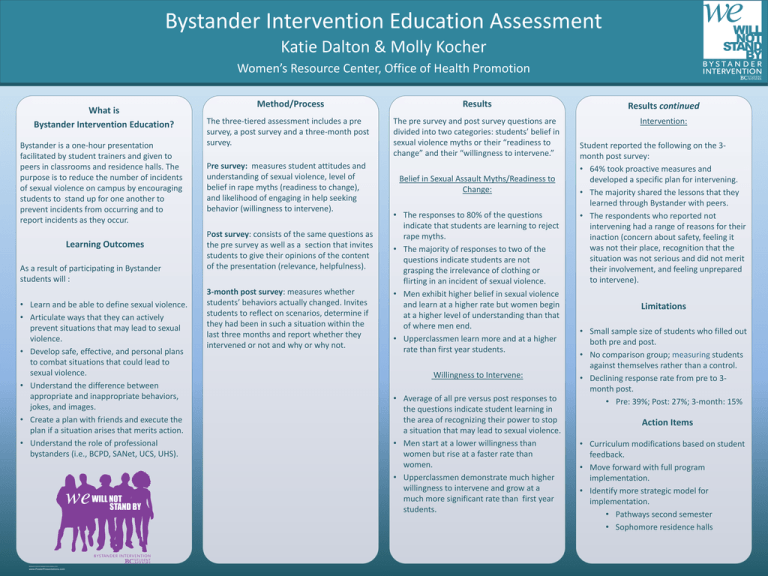
Bystander Intervention Education Assessment
Katie Dalton & Molly Kocher
Women’s Resource Center, Office of Health Promotion
What is
Bystander Intervention Education?
Bystander is a one-hour presentation
facilitated by student trainers and given to
peers in classrooms and residence halls. The
purpose is to reduce the number of incidents
of sexual violence on campus by encouraging
students to stand up for one another to
prevent incidents from occurring and to
report incidents as they occur.
Learning Outcomes
As a result of participating in Bystander
students will :
• Learn and be able to define sexual violence.
• Articulate ways that they can actively
prevent situations that may lead to sexual
violence.
• Develop safe, effective, and personal plans
to combat situations that could lead to
sexual violence.
• Understand the difference between
appropriate and inappropriate behaviors,
jokes, and images.
• Create a plan with friends and execute the
plan if a situation arises that merits action.
• Understand the role of professional
bystanders (i.e., BCPD, SANet, UCS, UHS).
RESEARCH POSTER PRESENTATION DESIGN © 2012
www.PosterPresentations.com
Method/Process
Results
Results continued
The three-tiered assessment includes a pre
survey, a post survey and a three-month post
survey.
The pre survey and post survey questions are
divided into two categories: students’ belief in
sexual violence myths or their “readiness to
change” and their “willingness to intervene.”
Intervention:
Pre survey: measures student attitudes and
understanding of sexual violence, level of
belief in rape myths (readiness to change),
and likelihood of engaging in help seeking
behavior (willingness to intervene).
Post survey: consists of the same questions as
the pre survey as well as a section that invites
students to give their opinions of the content
of the presentation (relevance, helpfulness).
3-month post survey: measures whether
students’ behaviors actually changed. Invites
students to reflect on scenarios, determine if
they had been in such a situation within the
last three months and report whether they
intervened or not and why or why not.
Belief in Sexual Assault Myths/Readiness to
Change:
• The responses to 80% of the questions
indicate that students are learning to reject
rape myths.
• The majority of responses to two of the
questions indicate students are not
grasping the irrelevance of clothing or
flirting in an incident of sexual violence.
• Men exhibit higher belief in sexual violence
and learn at a higher rate but women begin
at a higher level of understanding than that
of where men end.
• Upperclassmen learn more and at a higher
rate than first year students.
Willingness to Intervene:
• Average of all pre versus post responses to
the questions indicate student learning in
the area of recognizing their power to stop
a situation that may lead to sexual violence.
• Men start at a lower willingness than
women but rise at a faster rate than
women.
• Upperclassmen demonstrate much higher
willingness to intervene and grow at a
much more significant rate than first year
students.
Student reported the following on the 3month post survey:
• 64% took proactive measures and
developed a specific plan for intervening.
• The majority shared the lessons that they
learned through Bystander with peers.
• The respondents who reported not
intervening had a range of reasons for their
inaction (concern about safety, feeling it
was not their place, recognition that the
situation was not serious and did not merit
their involvement, and feeling unprepared
to intervene).
Limitations
• Small sample size of students who filled out
both pre and post.
• No comparison group; measuring students
against themselves rather than a control.
• Declining response rate from pre to 3month post.
• Pre: 39%; Post: 27%; 3-month: 15%
Action Items
• Curriculum modifications based on student
feedback.
• Move forward with full program
implementation.
• Identify more strategic model for
implementation.
• Pathways second semester
• Sophomore residence halls






